Chennai: Economist of rigour and realism

Chennai: In the passing away of the erudite, veteran development economist T.N. Srinivasan in Chennai at the age of 85 late on Saturday night — and not at Yale University as incorrectly mentioned in the news report, though his soul overcoming its bodily limitations from the Yale University campus in the U.S. with which he was associated for long years would have been equally fitting — the Indian economic scene has lost a gentle giant.
As this correspondent remembers covering one of his lectures in Chennai long years ago, T N Srinivasan came out as a thorough and sincere scholar, what with his mathematical and statistical backgrounds crowing his theoretical and economic policy endeavours. And he was not to flaunt any popularity tag.
In the social sciences, thanks to the persuasive power and equation precision of Econometric models, when T N Srinivasan was in the ascendant after getting his Ph.D. in Economics from Yale University in 1962 working under the famous Prof. Tjalling Koopmans, mathematical economics was the 'Queen' everyone wooed. This was despite everyone at the Delhi School of Economics not comfortable with her cool, calculated ways.
His range of contributions to the discipline were stupendous amid his wide-ranging interests including the Indian Economy, International Trade, Development Economics, Agricultural Economics, Law and Macroeconomic theory among others. And T N Srinivasan's publications are an equally long and impressive list, the most well known being his collaborative work with Prof. Jagdish Bhagwati, titled 'Foreign Trade Regimes and Economic Development: India' (Colombia University Press, 1975) to his more recent works, like 'Growth, Sustainability and India's Economic Reforms (Oxford India, 2011), followed by 'Economic Reform in India: Challenges, Prospects and Lessons (co-edited with N Hope, A. Kochar and R. Noll, (Cambridge University Press, 2014).
However, his seminal contributions, if one might say, that became part of an emerging policy eco-system in India when the first seeds of deregulation were sown in the mid-1960s', roughly after three Five year plans based on the Soviet model of Centralized planning, are to be gleaned in the famous book, “India Planning for Industrialisation — Industrial and Trade Policies since 1951 — by Prof Jagdish N Bhagwati and Padma Desai, both of whom were then at MIT. Prof. Bhagwati mentions the specific contributions made by Srinivasan in that work.
That book, though, was a major critique of the India’s planning process, where Bhagwati shows that “in certain important ways, India planned inadequately.” He points out that few grasped the “full dimensions of planning and development process faced by India around 1950”, even while making it clear that, “none of what we advocate is incompatible with the basic objectives of a socialist society.” Bhagwati also makes a point in that seminal work, “you can't have 'growth' first and 'efficiency' next, and that both have to go hand-in-hand.
Collaborating in some ways with Prof. Bhagwati within that emerging policy template, Prof T N Srinivasan's contributions — are succinctly summarized there: First was the major issue of 'industrial licensing', whether there was any “explicit economic criteria” in the grant or rejection of industrial licenses by the Central government. While the 'techno-economic examination' was supposed to be done by the now derided 'Directorate General of Technical Development (DGTD)', Prof Bhagwati points out that there was “no evidence of any studies having been carried out by the DGTD of the optimal size, time — phasing and location of industrial units, in order to guide the licensing committee in its deliberations.”
And it was in that area, that T N Srinivasan's later work with Alan Manne at the Indian Statistical Institute in Calcutta, which was to “develop techniques for such analysis,” says Prof Bhagwati, underscoring the importance of the former's work.
The second theoretical contribution concerned a “fundamental critique of Industrial policy”. Bhagwati refers to a seminal paper he co-authored with T.N. Srinivasan, titled, 'Licensing and Control of Industry'. It was a paper submitted to the Prime Minister's Conference for young Industrialists in Delhi in March 1966. They argued that since licensing was no effective way to curb monopolies or “reduction in concentration of ownership”, the same objective could be more “efficiently served by more positive action through easier access to credit and know-how to potential new-comers.” That triggered a key reformist impulse in economic policies though the abolition of licensing system had to wait till 1991 by then Finance Minister Dr Manmohan Singh under P. V. Narasimha Rao's tenure.
Prof Srinivasan's even more “fundamental” paper, as mentioned by Prof. Bhagwati, working with V.K. Ramaswamy, was in the area of tariff protection, another stumbling block to economic reforms. He says, “Ramaswami and Srinivasan have recently produced such an analysis which demonstrated the impossibility of devising any measure of effective rates of protection.” These three core contributions by T N Srinivasan in the mid-1960s' and early 1970s' that later facilitated India's economic reforms would always stand out. They vindicate former Finance Minister, P Chidambaram's by-now famous quip, “we are the original reformers.”

